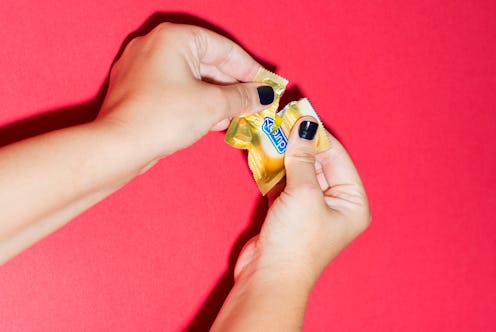Life
Here's What Experts Want You To Know About About Doubling Up On Birth Control Methods

No birth control method is effective 100 percent of the time, which can be nerve-wrecking if you're trying to avoid pregnancy. Will doubling up help, then? What about tripling up? Are certain birth control combinations more effective than others? Do they all even work well together, or could some cancel each other out?
"When relying on birth control pills for pregnancy prevention, they should be combined with backup contraception, like condoms, to prevent against sexually transmitted diseases," Dr. Lakeisha Richardson, OB/GYN and consultant to Allergan's Know Your Birth Control campaign, tells Bustle. "On this, it's important to note that birth control pills may also not be for everyone. Serious risks include blood clots, stroke, and heart attack. Women should speak to their healthcare provider to find out if the pill may be an option for them."
The most effective birth control methods (in order, according to the Centers for Disease Control and Prevention) are the implant, male sterilization, hormonal IUDs, female sterilization, copper IUDs, the Depo Provera shot, and the Pill. Less than one in 10 women who use these methods will get pregnant within a year. However, as you may have learned in health class, there's always at least a small chance of getting pregnant unless you completely abstain from sex.
And that's where using multiple methods can come in handy. Here are some things to know about combining birth control methods.
Condoms Are A Useful Addition To Hormonal Birth Control
Any hormonal birth control method, from the Pill to the patch to vaginal rings, can be used in conjunction with a condom. This is the most common combination because it protects against both pregnancy and STIs, certified nurse midwife Linda Rice tells Bustle. "Adding condom use increases the effectiveness to almost perfect," she says. "This is especially recommended when women may especially need a 'backup' method, like if they’ve not taken their pill correctly, or if they’re on a medication that may interfere with hormonal contraceptives."
But Don't Combine Multiple Condoms
You don't want to use two condoms because they could actually rub against each other and break. Combining a male and female condom is also going to pose some logistical difficulties. Female condoms are "made of a thicker material than male condoms, and it’s bunchy; it’s not a smooth fit," says Rice. "I suppose theoretically you could combine male and female condoms — I just don’t think it would be very comfortable."
Combining Hormonal Methods Is Usually Not Advisable
Hormonal birth control works by providing a certain amount of specific hormones, so their effects aren't additive, says Rice. Hormonal birth control can also have lots of side effects, so it's usually best to stick to one, says Richardson. "Being on several hormone-based birth control methods at one time significantly increases the risk of blood clots, stroke, and heart attack due to excess hormones," she says. "However, in some instances when a patient is changing birth control methods, such as going from an injection to a birth control pill, they may temporarily be on two birth control agents at one time."
But You May Combine Two Hormonal Methods For Medical Reasons
Some hormonal methods have side effects that other ones can counteract. "For those using progesterone-only methods, such as IUDs, Nexplanon, Depo Provera, etc., if bleeding irregularities are an issue, there are occasions where we may add back therapy in the way of a low-dose oral contraceptive pill to help rebuild the lining of the uterus, which is made thin by progesterone-only contraceptive methods," Astroglide’s resident sexual health advisor Dr. Angela Jones tells Bustle.
Experts Say It's Best Not To Use Barriers Alone
Barrier methods like condoms, female condoms, and diaphragms don't work as well as hormonal birth control or long-acting reversible contraceptives (LARCs) like IUDs, says Rice. So, if your chosen method is a barrier, you may want to select another method as well. You can combine different barrier methods, like condoms and a diaphragm or cervical cap, or combine one with spermicide or hormonal birth control.
Definitely Don't Use The Pullout Method Alone
The pullout method is rising in popularity, but it's not very effective on its own. About one in five women who use it get pregnant every year, largely because it's difficult to use successfully (and even then, you can get pregnant from precum). If you're going to use it, find a backup method as well. And since it doesn't protect against STIs, use a condom if that's a goal of yours.
And Whatever You Do, Don't Use The Rhythm Method Alone
The rhythm method — when you have sex during your least fertile time of month — can decrease your chances of pregnancy, but not to the point that it's an effective birth control method on its own. Its success rate is even lower than the pullout method, with about a quarter of women who use it getting pregnant each year. It's impossible to predict exactly when you're fertile, and even if you get it right and only have sex when you're not, sperm can survive in your body for up to five days, Anna Druet, science and education manager at Clue, tells Bustle. Even if you're using a period-tracking app to determine the times when you're the least fertile and have sex then, you should also be using some other form of birth control.
So, in short, using multiple birth control methods is a good idea in general, but you'll probably want to avoid using two of the same kind. And some methods definitely should be used with at least one other one.
This article was originally published on